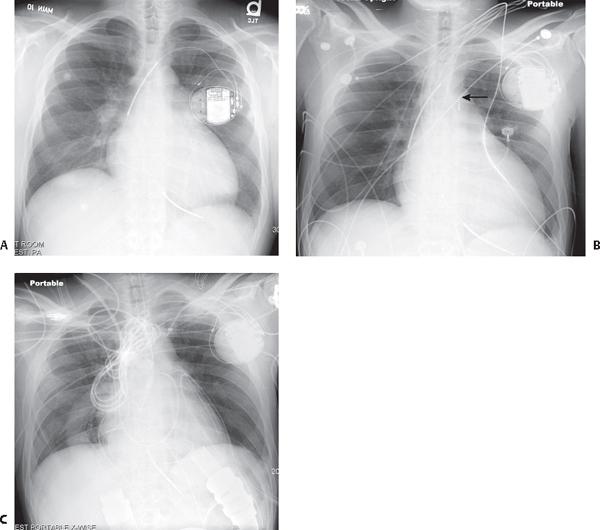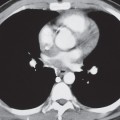CASE 151 26-year-old man with non-ischemic cardiomyopathy and progressive decline in cardiac function Baseline AP chest radiograph (Fig. 151.1A) shows global enlargement of the cardiac silhouette and decreased vascular clarity from mild pulmonary edema. Note the left subclavian approach transvenous right ventricular ICD. Chest radiograph two days later after medical therapy failure reveals placement of an intra-aortic balloon pump (Fig. 151.1B). Note the radio-opaque metallic marker of the device confirming appropriate positioning in the proximal descending thoracic aorta (arrow). The edema has improved. Chest radiograph obtained three days later shows placement of a left ventricle assist device (LVAD) (Fig. 151.1C). The inflow housing, outflow housing, and conduit can be seen. The sternum is still open. Note the lap sponges at the pericarinal level. Fig. 151.1 Circulatory Assist Devices: Intra-Aortic Balloon Pump, Left Ventricular Assist Device None Circulatory assist devices were initially used to support patients in hemodynamic collapse. Today, these devices are used for a wide range of clinical conditions ranging from prophylactic insertion for invasive procedures to cardiogenic shock and cardiopulmonary arrest. The two most commonly employed devices are the intra-aortic balloon counterpulsation pump and the left ventricular assist device. The IABP remains the most commonly used mechanical circulatory assist device. Its primary purpose is to increase myocardial oxygen supply while reducing its demand. Secondary purposes include improving cardiac output and ejection fraction; increasing coronary perfusion pressure and systemic perfusion; and reducing heart rate, pulmonary capillary wedge pressure, and systemic vascular resistance. Early indications for use included cardiac surgery, left ventricular failure, unstable angina, and failure to come off cardiopulmonary bypass. Prophylactic applications include stabilizing both cardiac and non-cardiac surgical patients. More recent applications include supporting cardiac patients during coronary angiography and percutaneous transluminal angioplasty, drug-induced cardiac failure, myocardial contusion, or septic shock, and as a bridge to transplant. The LVAD is a mechanical circulatory assist device used to partially or completely replace the function of the failing heart. Indications for short-term use include cardiogenic shock or post-cardiopulmonary bypass (CPB) low-output syndrome. Long-term use is reserved for patients with end-stage heart failure who are not candidates for heart transplant (destination therapy) and as a bridge to eventual transplantation. The pumps used in the LVAD are divided into two main types: (1) the pulsatile pump, a positive displacement pump that mimics the natural pulsatile action of the heart and requires an air vent tube; and (2) the continuous-flow pump, which uses either a centrifugal or axial flow pump and contains a central rotor that rotates in response to an electric current applied to permanent magnets. The 8.5–9.5F vascular catheter is introduced percutaneously via the femoral or axillary artery or directly into the descending thoracic aorta at thoracotomy. It is advanced retrograde just distal to the left subclavian artery. A 26–28 mm inflatable balloon is mounted on this vascular catheter. Helium gas is pumped from the bedside console to the balloon. The balloon inflates with the onset of diastole and deflates during isometric contraction or early systole and is phasically pulsed in counterpulsation to the patient’s cardiac cycle. Total or regional blood flow is improved during balloon inflation, as is collateral coronary artery circulation.
 Clinical Presentation
Clinical Presentation
 Radiologic Findings
Radiologic Findings

 Diagnosis
Diagnosis
Differential Diagnosis
 Discussion
Discussion
Background
Intra-Aortic Balloon Pump (IABP)
Left Ventricular Assist Device (LVAD)
Clinical Findings
IABP
LVAD
Stay updated, free articles. Join our Telegram channel

Full access? Get Clinical Tree






